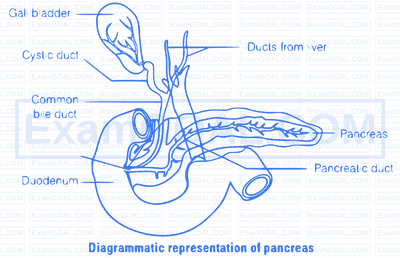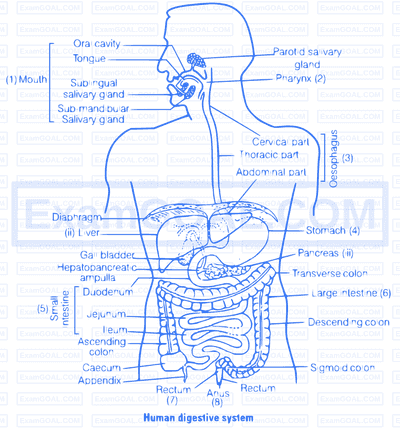The pancreas is a compound (both exocrine and endocrine) elongated organ situated between the limbs of ' $U$ ' shaped duodenum.

Internal structure of pancreas consist of two parts, i.e., the exocrine and endocrine part.
(i) Exocrine part consists of rounded lobules called acini that are involved in the secretion of alkaline pancreatic juice of pH 8.4. The pancreatic juice is mainly involved in the digestion of starch, proteins, fats and nucleic acids.
(ii) Endocrine part is involved in the secretion of hormones like, insulin and glucagon that regulate glucose metabolism.
Small intestine is the principle organ for the absorption of nutrients. The process of digestion complete here only and the final products of digestion are absorbed through the mucosa into the blood stream.
The absorbed form of different food materials are
| Food Material | Absorbed Form |
|---|---|
| Carbohydrate | Glucose |
| Protein | Amino acid |
| Fat | Fatty acid |
Human digestive system consists of two main parts, alimentary canal and digestive glands.
Alimentary canal comprises of following parts
(i) Mouth (ii) Pharynx (iii) Oesophagus (iv) Stomach (v) Small intestine (vi) Large intestine (vii) Rectum (viii) Anus
Digestive glands include
(i) Salivary glands are situated just outside the buccal cavity and secrete salivary juice into it.
(ii) Liver is the largest gland in the body, situated in the abdominal cavity just below the diaphgram and has two lobes. It secreates bile which helps in the digestion of fats.
(iii) Pancreas is the compound organ situated between the limbs of U-shaped duodenum acting as endocrine and exocrine organ. The exocrine portion secretes pancreatic juice where endocrine portion secretes hormones like insulin and glucagon.

Correct the statements given below by the right option shown in the bracket against them.
(a) Absorption of amino acids and glycerol takes place in the (small intestine/ large intestine).
(b) The faeces in the rectum initiate a reflex causing an urge for its removal (neural/ hormonal).
(c) Skin and eyes turn yellow in infection (liver/stomach).
(d) Rennin is a proteolytic enzyme found in gastric juice in (infants/ adults).
(e) Pancreatic juice and bile are released through (intestine pancreatic/ hepato-pancreatic duct).
(f) Dipeptides, disaccharides and glycerides are broken down into simple substances in region of small intestines (jejunum/ duodenum).
(a) Absorption of amino acids and glycerol takes place in the small intestine.
(b) The faeces in the rectum initiate a neural reflex causing an urge for its removal.
(c) Skin and eyes turn yellow in liver infection.
(d) Rennin is a proteolytic enzyme found in infants gastric juice.
(e) Pancreatic juice and bile are released through hepato-pancreatic duct. (f) Dipeptides, disaccharides and glycerides are broken down into simple substances in the region of small intestine called duodenum.